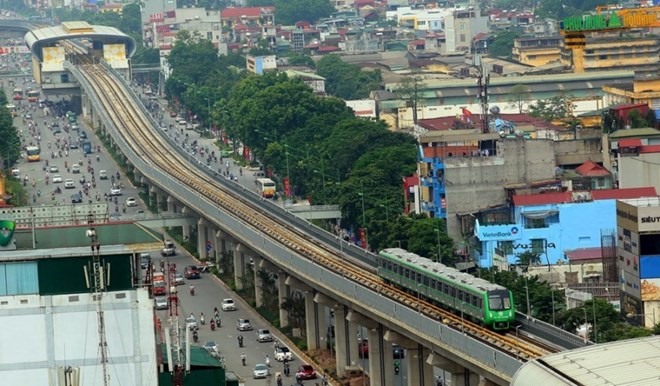 Society
Society

The cost of a ticket for the Cát Linh – Hà Đông elevated metro line will be subsidised.
 |
| The Cát Linh - Hà Đông metro line being piloted this month. - VNA/VNS Photo Huy Hùng |
HÀ NỘI — The cost of a ticket for the Cát Linh – Hà Đông elevated metro line will be subsidised.
The announcement was made by Vũ Hồng Trường, director of the Metro Hà Nội Company at Friday’s online seminar on ‘How Hà Nội’s first elevated railway will operate?’ hosted by the Railway Project Management Board under the Ministry of Transport.
A survey released during the seminar shows that 98 per cent of people asked knew about the project and 95 per cent wanted to try the metro.
Regarding the cost of tickets, the majority of surveyed people thought it is acceptable for metro tickets to be 35 to 37 per cent higher than those for normal buses. However, most said they would prefer using a monthly pass and accept a range of 10 to 15 per cent higher than the price for a bus ticket.
According to Trường, the price range will be decided by Hà Nội People’s Committee, aiming to encourage citizens to use public transportation and compete with private vehicles. However, the cost will be not too high thanks to the Government’s subsidy.
Hà Nội authorities have announced a common standard for public transportation monthly passes which will allow the metro and buses to share the same technology. In the near future, these tickets are expected to be used for parking lots around the city.
Chu Quang Trung, deputy head of the Transport Development and Strategy Institute said that the convenient connection between the metro and other transportation could sufficiently satisfy people’s demands. There are 34 bus routes along the Cát Linh – Hà Đông metro line, accounting for 30 per cent of Hà Nội’s bus network.
When the metro line comes into operation, those bus routes will help transport metro passengers to and from other areas of the city. All metro stations will connect with the city bus system.
Moreover, according to Nguyễn Hoàng Hải, director of Hà Nội Public Transport Management and Operation Centre, the metro system will be accessible for pedestrians and riders of other private vehicles as parking spaces will be offered near metro stations.
Taxis and buses are not “rivals”, experts confirmed at the seminar.
Hồ Quốc Phi, deputy head of Hà Nội Taxi Association, stressed the significance of connections with other means of transportation to attract more passengers to the metro.
“Hà Nội is preparing for its first metro line. Once eight metro lines come into operation, traffic congestion in Hà Nội will be eased,” he said.
Nguyễn Công Nhật, deputy director of Hà Nội Transportation Service Corporation (Transerco) said that metro passengers could use public buses as a mean of transiting.
Approving the idea, Ngô Mạnh Tuấn, deputy director of Hà Nội Department of Transport, said that minibuses would help to gather passenger for other bus routes and the metro system.
“To reduce the number of private vehicles, it is essential to have more minibuses. We are working on this plan,” he added.
Ninety-six per cent of the Cát Linh – Hà Đông elevated railway project is completed, the rest is being adjusted.
Since August 1, the railway has been connected to the national power grid for its trial operation this month.
Vũ Hồng Phương, deputy director of the Railway Project Management Board, said that 681 workers participated in on-site training courses in order to manage and operate the project in the future. The elevated railway line will stretch over 13km, connecting Đống Đa District’s Cát Linh Street with the Yên Nghĩa Bus Station in Hà Đông District. It includes 12 stations and a depot at Phú Lương Ward in Hà Đông District.
The railway will operate 13 trains with four carriages each running every two minutes at speeds of 35 to 80kmph.
The railway has been constructed using Official Development Assistance from China with a total investment of US$868 million.
The China Railway Sixth Group is the EPC (Engineering, Procurement and Construction) contractor for the project. — VNS